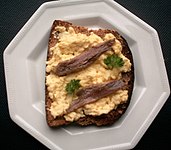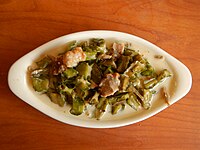Anchovies as food

Anchoviesare small, commonsaltwaterforage fishin the familyEngraulidaethat are used as human food and fish bait. There are 144 species in 17 genera found in theAtlantic,Indian,andPacific Oceans.Anchovies are usually classified asoily fish.[1]They are small, green fish with blue reflections due to a silverlongitudinalstripe that runs from the base of thecaudal fin.They range from 2 centimetres (0.79 in) to 40 centimetres (16 in) in adult length,[2]and the body shape is variable, with more slender fish in northern populations.
A traditional method ofprocessingandpreservinganchovies is to gut andsaltthem inbrine,allow them tocure,and then pack them in oil or salt. This results in the characteristic strong flavor associated with anchovies, and their flesh turns deep grey. Anchoviespickled in vinegar,as with Spanishboquerones en vinagre,are milder, and the flesh retains a white color. For domestic use, anchovyfilletsare sometimes packed in oil or salt in small tins or jars, sometimes rolled aroundcapers.Anchovy pasteis also available, as isanchovy essence.Anchovy mash is also sold in the UK under the label ofGentleman's Relish.[3]
They are used in small quantities to flavor many dishes. Because of the strong flavor of anchovies, they are also an ingredient in several sauces, includingWorcestershire sauce,remouladeand manyfish sauces,and in some versions ofCafé de Paris butter.Anchovies are a popularpizza toppingin some places.[4]InRoman times,anchovies were the base for thefermented fishsaucegarum.Garum had a sufficiently long shelf life for long-distance commerce and was produced in industrial quantities. Anchovies were alsoeaten rawas anaphrodisiac.[5]
Additionally,fishermenuse anchovies asfish baitfor larger fish, such astunaandsea bass.[6]
Preparation and marketing[edit]
The strong taste people associate with anchovies is due to thecuringprocess. Fresh anchovies, known inItalyasalici,have a much milder flavor.[7]The rare alici (anchovies - in the local dialect: "Sardoni barcolani" ) from the Gulf of Trieste nearBarcola,which are only caught atSirocco,are particularly sought after because of their white meat and special taste and fetch high prices for fishermen.[8]
InSwedenandFinland,the name anchovies is related strongly to a traditional seasoning. Hence, the product "anchovies" is normally made ofsprats,[9]while fish such asherringcan be sold as "anchovy-spiced", leading to confusion when translating recipes.[citation needed]
TheEuropean anchovy,Engraulis encrasicolus,is the main commercial anchovy, withMoroccobeing the largest supplier of canned anchovies.[10]The anchovy industry along the coast ofCantabria,initiated in Cantabria by Sicilian salters in the mid-19th century, now dwarfs the traditionalCatalansalters.[10]
-
DriedJapanese anchovy
-
Salted and fermented anchovy (jeotgal) Korea
-
Canned anchovies
-
Workers handling anchovies in a canning company inCantabria,Spain
-
Workers cleaning dried anchovies at a market inMae Sot,Thailand
-
Anchovy at the market, Turkey
Uses[edit]
This sectionneeds additional citations forverification.(July 2021) |
In English-speaking countries,aliciare sometimes called "white anchovies", and are often served in a weak vinegar marinade, a preservation method associated with the coastal town ofColliourein southwest France. The white fillets (a little like marinatedherrings) are sold in heavy salt, or the more popular garlic or tomato oil and vinegar marinade packs.
Once available on the toppings menu at most pizza parlors--though seldom a big seller--across the United States, nowadays anchovy pizzas have been largely abandoned by most pizza chains, but are still usually available on pies sold by fine restaurants, as well as at many independent pizzerias.
InSpainthey are called "bocarte" when consumed as freshly cooked fish, "anchoa" when salted and commonly sold in cans and "boquerón" when marinated in vinegar and very commonly consumed as snack or appetizer. (Engraulidae[es])
In Southeast Asian countries, anchovies are known asikan teriin Indonesia,ikan bilisorsetipinna tatyin Malaysia (ikanbeing theMalayword for fish); anddilis,gurayan,monamon,gunoorbolinawin the Philippines. They are usually sold dried, but are also popularly used in fermented condiments like the Philippinebagoongand Malaysianbudu.Ikan bilisis normally used in a similar way todried shrimpinMalaysian cuisine.In Indonesia, Malaysia, the Philippines and Singapore anchovies are commonly used to makefish stockor are deep fried. Anchovies are also popular ingredients for the traditional Javanesesambal.
In Vietnam, anchovy is the main ingredient in thefish sauce-nước mắm- the unofficial national sauce of Vietnam.[11]InThai cuisine,dried anchovies are calledpla katak haeng.They are used in a variety of dishes and especially popular deep-fried as a snack. Similarly to Vietnamese fish sauce, Thai fish sauce (nam pla) is also often made from anchovies. In other parts of Asia, such as Korea and Japan, sun-dried anchovies are used to produce a rich soup similar tosetipinna taty.These anchovy stocks are usually used as a base for noodle soups or traditional Korean soups. There are many other variations on how anchovies areused in Korea.
Fresh and dried anchovies are a popular part of the cuisine inKeralaand other south Indian states, where they are referred to asnetholi/chooda(andnethiliin Tamil Nadu) and provide a cheap source of protein[12]in the diet. Fresh anchovies are eaten fried or as in a spicy curry.
In Turkey, anchovies are known ashamsiand are eaten between November and March. They are generally consumed fried, grilled, steamed andpilav.[13]
-
Scotch woodcock,scrambled eggs on toast spread with anchovy (United Kingdom)
-
Sambal teri kacang,fried anchovies with peanuts and chili (Indonesia)
-
Anchoa en salazón,anchovyfilletsin oil and salt (Spain)
Health concerns[edit]
Anchovies can concentratedomoic acidin their gut which causesamnesic shellfish poisoningin humans when eaten whole. If suspected, medical attention should be sought.[14]
See also[edit]
References[edit]
- ^"What's an oily fish?".Food Standards Agency.2004-06-24. Archived fromthe originalon 2010-12-10.Retrieved2012-04-15.
- ^Froese, Rainer, and Daniel Pauly, eds. (2008)."Engraulidae"inFishBase.December 2008 version.
- ^Two Fat Ladies cooking show
- ^Belfast, Frederick Richard Chichester Earl of (1856).Naples: Political, Social, and Religious.T. C. Newby.
- ^"Tacitus: Germania".thelatinlibrary.
- ^Enns, Darren."Fishing With Anchovies".Fishin Money- Fishing Tips.Retrieved2021-05-21.
- ^"White Anchovy Fillets (Boquerones)".marxfoods.
- ^Georges Desrues "Eine Lange Nacht am Meer", In: Triest - Servus Magazin (2020), p 73.
- ^"Food: First catch your anchovies".The Independent.22 November 1997.Archivedfrom the original on 2009-07-14.
- ^ab"Homage to the Anchovy Coast".Smithsonian.
- ^Kuronuma, Katsuzo (1961).A Check List of Fishes of Vietnam.U.S. Operations Mission to Vietnam.
- ^"Dangers of eating anchovies".Pharmaceutical Journal.Retrieved2018-07-05.
- ^"Hamsi".Archived fromthe originalon 2012-05-01.Retrieved2012-04-15.
- ^Domoic Acid PoisoningArchived2012-02-13 at theWayback MachineNorthwest Fisheries Science Center,NOAA.Retrieved 16 July 2012.
External links[edit]
- Chisholm, Hugh,ed. (1911)..Encyclopædia Britannica(11th ed.). Cambridge University Press.
- Consider the anchovyGuardian,18 January 2011.
- The height of good pasteThe Telegraph,28 December 2000.















